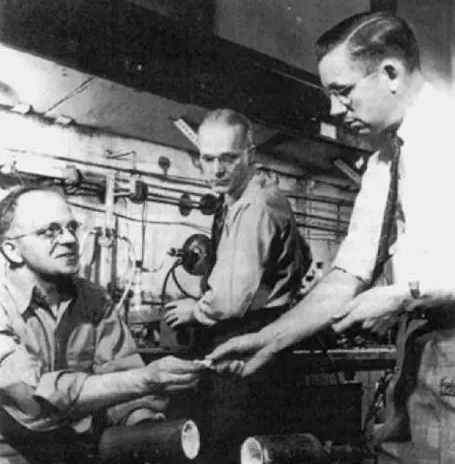If you are looking for high-quality products, please feel free to contact us and send an inquiry, email: brad@ihpa.net
PTFE, notoriously known as Teflon, was not a planned discovery. In 1938, DuPont came across this remarkable material rather by accident, sparking a transformation in products science and commercial applications.
One morning in 1938, Roy Plunkett, a young chemist, was busy having fun with his experiments in a corner of DuPont. His task seemed straightforward: discover a brand-new refrigerant.
(Roy and his colleagues)
Nonetheless, simply when Roy thought it was just a routine task, points took a turn. He kept the tetrafluoroethylene gas in a cyndrical tube and said to himself: “Okay, see you tomorrow.” The next day, when he went back to proceed his experiment, he found that the gas had mysteriously vanished, leaving only a stack of white powder. Well, this was absolutely various from the script he prepared. Envision his expression at that time: half baffled, half curious. Upon additional examination, he found that this weird white powder had some awesome superpowers: it was unfriendly to almost all chemicals, can stay great at severe temperatures, and was as unsafe as oil. Suddenly, Luo understood that while he had yet to discover a new refrigerant, he had actually mistakenly found the secret ingredient of the kitchen area superhero of the future – non-stick pans. From then on, frying eggs was no more a challenge, and cleansing pots came to be a wind.
Although the exploration of PTFE was unexpected, it had substantial innovative relevance for the plastics market and many other fields, such as aerospace, vehicles, electronic devices, and devices. PTFE is extensively used due to its one-of-a-kind chemical and physical residential or commercial properties – exceptionally reduced friction coefficient, high-temperature resistance, chemical security, and non-stickiness. From kitchen area tools to important parts of the space capsule, PTFE made several ingenious applications possible. Yet while PTFE (Teflon ®) noted an advanced breakthrough in products scientific research, it was only the beginning of a long and tough roadway to commercialization and prevalent application. The first challenge was not only to uncover a new material however additionally to figure out how to achieve large production and how to use it in different fields.
The procedures of monomer synthesis and controlled polymerization of PTFE were not completely established, making it tough to generate PTFE in big amounts or a viable manner. While the material’s special residential properties were useful in the long run application, they additionally presented considerable challenges during the manufacturing procedure. Unlike other regular plastics, PTFE is not soluble in solvents, acids, or bases and does not melt into a flowable fluid. Instead, when heated, it comes to be a hard, clear gel that does not melt and moves like plastics.
(Roy’s Notes: Discovery of PTFE)
To get rid of these difficulties, researchers and designers had a hard time to find processes from other areas, such as adjusting methods from metal and ceramic handling. To form PTFE, a process called paste extrusion was made use of, which was obtained from ceramic handling. Although conventional molding and developing techniques had some problem refining PTFE, it was feasible to develop PTFE parts. By 1947, extensive study and testing had actually flourished, and a small production center was established in Arlington, New Jacket. This noted the beginning of Teflon ®’s journey from the research laboratory to the market. In 1950, DuPont opened a new plant in Parkersburg, West Virginia, substantially expanding the industrial manufacturing of Teflon ®. That exact same year, the modern technology went across the Atlantic when Imperial Chemical Industries developed the initial PTFE plant outside the United States in the UK.
Supplier of PTFE Powder
TRUNNANO is a supplier of 3D Printing Materials with over 12 years experience in nano-building energy conservation and nanotechnology development. It accepts payment via Credit Card, T/T, West Union and Paypal. Trunnano will ship the goods to customers overseas through FedEx, DHL, by air, or by sea. If you want to know more about polycarboxylate concrete admixture, please feel free to contact us and send an inquiry.
Inquiry us

